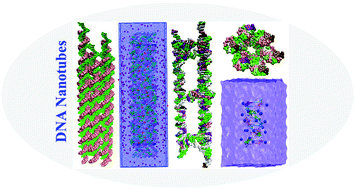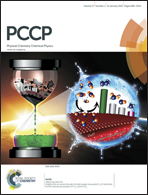Structure, stability and elasticity of DNA nanotubes†
Abstract
DNA nanotubes are tubular structures composed of DNA crossover molecules. We present a bottom up approach for the construction and characterization of these structures. Various possible topologies of nanotubes are constructed such as 6-helix, 8-helix and tri-tubes with different sequences and lengths. We have used fully atomistic molecular dynamics simulations to study the structure, stability and elasticity of these structures. Several nanosecond long MD simulations give the microscopic details about DNA nanotubes. Based on the structural analysis of simulation data, we show that 6-helix nanotubes are stable and maintain their tubular structure; while 8-helix nanotubes are flattened to stabilize themselves. We also comment on the sequence dependence and the effect of overhangs. These structures are approximately four times more rigid having a stretch modulus of ∼4000 pN compared to the stretch modulus of 1000 pN of a DNA double helix molecule of the same length and sequence. The stretch moduli of these nanotubes are also three times larger than those of PX/JX crossover DNA molecules which have stretch moduli in the range of 1500–2000 pN. The calculated persistence length is in the range of a few microns which is close to the reported experimental results on certain classes of DNA nanotubes.


 Please wait while we load your content...
Please wait while we load your content...